Applying the meaning of argumentation in a range of relevant contexts
Applying the meaning of argumentation in a range of relevant contexts
Rationale
In our exploration of the questions “How do we introduce students to the meaning of argumentation? What can be some discipline-specific considerations in doing so?” we discussed the need for instructors to introduce their students to a meaning of argumentation that meets disciplinary standards and is appropriate for their joint classroom work. The focus of this section is what happens next.
The notion of argument is a complex one and simply introducing students to it is not enough for students to understand it and be able to apply it when appropriate. Students need opportunities to apply their developing understanding of argumentation in a wide range of contexts so that they can see its relevance and solidify their understanding. In this section we explore the issue of how the application of the meaning of argumentation in a range of relevant contexts might look like when the students in the classroom are (pre- or in-service) mathematics and science teachers. Certain strategies and resources we offer can apply more broadly to other student populations as well.
Pedagogical Strategies
Justification of argumentation in own area of work & argumentation as a transferrable skill
In this video clip, Professor Sibel Erduran justifies argumentation as a skill in her teaching of in-service science teachers who are participating in a part-time Master’s programme in Teaching and Learning. She explores with the class why argumentation is important in science teaching and learning and how argumentation can be viewed as a useful and transferrable skill. The pedagogical strategies involve the use of explanations to justify why argumentation is important in a particular context and across contexts.
Establishing criteria and content of argumentation
In this video clip, Professor Sibel Erduran brainstorms about the criteria for what can be considered ‘argumentation’ and invites the participants to consider the content of arguments. The context is a part-time Master’s programme in Teaching and Learning where science teachers are pursuing professional development on science teaching. She explores with the class. The pedagogical strategies involve the generation of criteria and content for what counts as argumentation in general and in science teaching and learning in particular.
Introducing tasks with explicit focus on argumentation
Coursework tasks in higher education are developed with a larger teaching team and cannot be easily altered, but it may still be possible to introduce tasks with explicit drawn attention to features of assignment where argumentation skills are being used naturally.
In this video, Dr Liam Guilfoyle guides students through their upcoming task. This is a uniform task uniform across all subjects of the MLT programme, so it is not specifically designed with argumentation in mind. However, this video shows how such tasks can be introduced with specific links drawn to argumentation.
Dr Guilfoyle begins by stating the intention to signpost the link between argumentation students have already learned about and their upcoming task. Then he highlights the language of the task to the language of argumentation, particularly focusing ‘data’, ‘interpretations’ and ‘discussion’. Visual resources are used to map the assignment to these key components features that are relevant for argumentation.
This section naturally precedes Strategy 4: Modelling arguments and Using examples of arguments from student writing & Strategy 5: Scaffolding research tasks for argumentation
|
|
|
|
|
|
Modelling arguments and using examples of arguments from student writing
This section naturally follows from Strategy 3: Introducing tasks with explicit focus on argumentation.
In this video, Dr Liam Guilfoyle uses an example of student work to show to recognise arguments in such texts. This helps to make the abstract language and structure of argumentation more concrete by contextualising it arguments that would be relevant for the students. Further, it models how students might write arguments when interpreting data and discussing findings in their own tasks.
Dr Guilfoyle extracts short pieces of text from a student task and explicitly relates it to the structures already introduced. In doing so, he also shows are some of the claims might be contested or alternatively constructed.
Scaffolding research tasks for argumentation
This section naturally follows from Strategy 4: Modelling arguments and using examples of arguments from student writing.
In this video, Dr Liam Guilfoyle provides students with two writing frames to scaffold their writing and construction of arguments. The writing frames include some examples of sentence stems to make obvious what might be included in each component. They are introduced as tools for thinking, rather than being rigid or mandatory structures to follow. It is important to provide students the tools for making their arguments explicit. However, requiring a formulaic approach may also lead to poorly communicated arguments.
Scaffolds can be very useful in recognising the various components of an argument and the function of each component. The intention is to build an understanding of the terminology and structure of argumentation. Once this is achieved, class discussions can be more fruitful as we critique ‘claims’ and ‘interpretations’ or seek ‘evidence’ and ‘warrants’ with a fluency of what these terms mean.
|
|
Applying the notion of argumentation in the school context: Two important considerations
The application of the notion of argumentation can take different forms in different contexts. In the school context, for example, when engaging students to the meaning of argumentation, teachers need to consider both disciplinary and student factors and try to maintain an appropriate balance between the two. This applies to mathematics but also other subject areas as well. The slides below were used by Professor Gabriel Stylianides to introduce his prospective mathematics teachers to these two considerations, which apply equally to other notions beyond argumentation such as task design, definitions, representations.
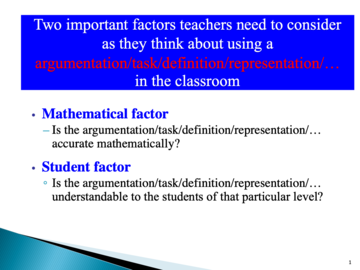
|
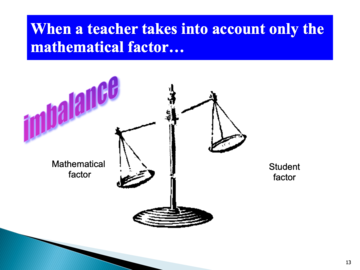
|
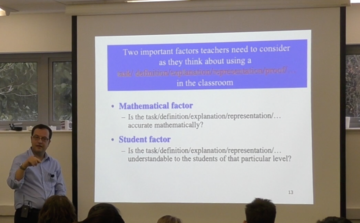
|
To practice the two considerations, Stylianides asked the prospective teachers to produce at least one non-algebraic proof for a mathematical statement as in the slide below. The requirement for one non-algebraic proof was because, according to the scenario Stylianides gave to the prospective teachers, the school students did not have the algebraic skills to produce an algebraic proof. Accordingly, the teacher in the scenario would need to try and come up with a proof that not only the students could understand but that would also satisfy the mathematical consideration.
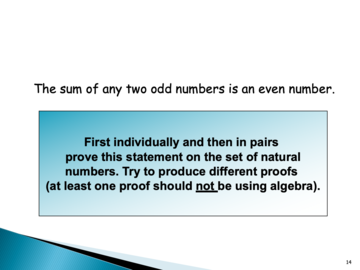
Once the prospective teachers produced different kinds of proofs they then watched a video from Carpenter et al. (2003) showing a primary school student producing a non-algebraic proof for the same statement.
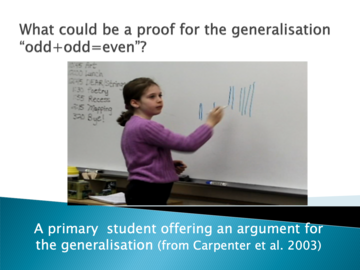
This was followed by a discussion about the student’s argument (summarised in the PowerPoint slide below) and the prospective teachers’ non-algebraic arguments, some of which were strikingly similar to the student’s argument. There was also discussion of how different proofs for the “odd+odd=even” statement corresponded to each other (see picture below).
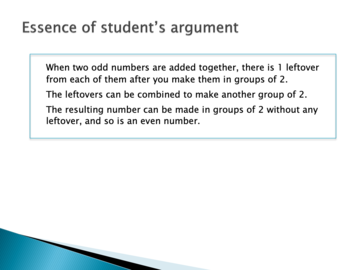
|
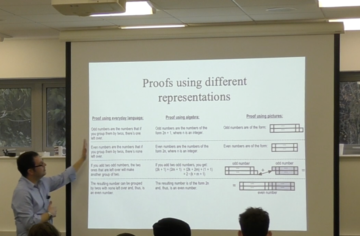
|


